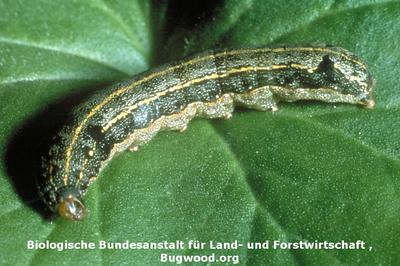Mediterranean Brocade Moth
Spodoptera littoralis
Mdudu
Kwa Ufupi
- Caterpillars feeding on all plant parts.
- Extremely polyphagous attacking many crops.
- Retarded plant development.
- Small to no fruit production.
Inaweza pia kupatikana kwenye
Dalili
Larvae cause significant damage by heavy feeding, often stripping plants completely. They prefer young, tender leaves but also feed on growing points, young shoots, stalks, buds, fruits and all plant parts. Larvae chew inside the stems making holes and letting other diseases in. If larvae feed on a young plant heavily, the plant’s development is retarded and it may only produce small or late fruit.
Mapendekezo

Udhibiti wa Kiasili
Proper integrated pest management starting with prevention is very important. The usage of pheromone traps for detection as well as mass trapping and mating disruption is very important.

Udhibiti wa Kemikali
This pest is resistant to many chemical compounds. Always consider an integrated approach with preventive measures together with biological treatments if available.
Ni nini kilisababisha?
It is common in areas with few winter frosts. Both the eggs and larvae can be introduced to the field by planting material or seedlings. The adult is about the size of a small grape. Its wings are gray-brown with white lines Female moths lay most of their egg masses (20 to 1,000 eggs) on the lower leaf surface of younger leaves or upper parts of the plant: eggs are whitish-yellow and covered with hair scales from the female’s abdomen. Larvae grow to about the length of a thumb, are hairless and vary in color (dark gray to dark green, becoming reddish-brown or light yellow at later stages).
Hatua za Kuzuia
- To monitor the insect’s activity, place 1 pheromone trap per acre, 1 to 2 m above the ground.
- Minimize random unnecessary pesticide spraying to favor beneficial bugs that can predate and keep the populations under control.
- Inspect seedlings before planting to eliminate any egg masses or caterpillars.



